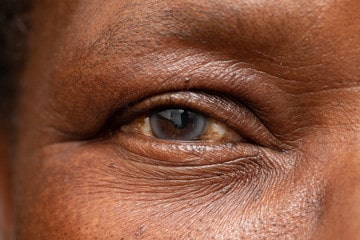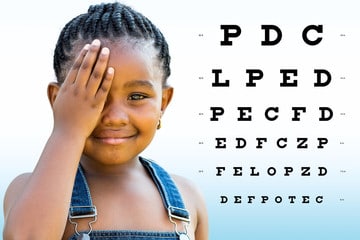Eye diseases or Ocular problems are serious conditions that can cause visual difficulties. They vary in distribution across the world due to racial, geographical and socio-economic factors. Below are the five common eye diseases in Nigeria: [1]
5 Common Eye Diseases in Nigeria

The prevalence of eye diseases in Nigeria varies from state to state. However, it can be said that millions of Nigerians suffer from one form of eye problem. Here are 5 common eye diseases in Nigeria in no particular order. [2]
1. Presbyopia
This is a gradual loss of the ability of the eye to focus on near objects. It is also considered a part of the aging process as it is noticeable in persons in their mid 40’s and continues to worsen until around age 65. Also, one survey found it to be one of the most common eye diseases in Nigeria affecting children. [3]
Cause
For an image to form, the eyes need the cornea and lens to focus the light reflected from objects. The lens which is more flexible than the cornea can change its shape with the help of the circular muscles that surrounds it. These muscles relaxes and constricts when one looks at something at a distance or close-up, respectively, allowing the somewhat elastic lens to curve and change its focusing power. Presbyopia is caused by a hardening of the lens mostly due to age. When this happens, the inflexible lens is unable to change its shape to focus on close objects.
Common Symptoms
- Headaches/eye strain after reading
- Difficulty reading small prints
- Difficulty seeing and focusing on objects that are close to you
- Need for brighter lighting when reading
- Need to hold reading materials at arm’s length to focus properly
Risk Factors
- Age: Considered the greatest risk factor as almost everyone experiences some degree of presbyopia after age 40.
- Other medical conditions: Having certain diseases such as diabetes, multiple sclerosis or cardiovascular diseases can increase the risk of premature presbyopia.
- Drugs: Prolonged usage of certain drugs, e.g. antidepressants, antihistamines and diuretics, are associated with premature presbyopia symptoms.
Diagnosis
Basic eye examination which includes refraction assessment and eye health examination
Treatment
Wearing corrective eyeglasses or contact lenses
Getting a lens implant for presbyopia
Undergoing refractive surgery
2. Glaucoma
Glaucoma is a group of eye conditions that cause gradual damage to the optic nerves which can lead to vision loss and blindness if left untended. It is of different types but the two main types, marked by the pressure in the eye, are Open-angle (considered to be more prevalent) and angle-closure.
Cause
Scientists are still not sure what causes the most common types of glaucoma, but many people with this issue have high eye pressure (intraocular pressure). It tends to be inherited and may not show up until later in life.
Symptoms
Glaucoma doesn’t usually have any visible symptoms though some people may have:
Eye pain
- Seeing halos around lights
- Redness in the eye
- Nausea/vomiting
- Narrowed vision
- Slow loss of vision usually starting with side vision
- Blindness if left unchecked.
Risk Factors
- Family History
- Over the age of 60
- African American or Hispanic/Latino and over age 40
- Have had trauma to the eye or ear
- Certain medical conditions like diabetes, heart disease, high blood pressure and sickle cell anaemia
Diagnosis
- Comprehensive dilated eye examination
- Treatment
- Medicines such as prescription eye drops
- Laser Treatment
- Surgery if medicines and lasers do not work
3. Cataract
A cataract is a clouding of the lens of the eye. It is considered one of the most common causes of vision loss in people over age 40 in Nigeria and a principal cause of blindness around the world. It scatters and blocks the light that passes through the lens, preventing a sharply defined image from reaching the retina resulting in blurred vision. One study on the ocular problems among public service retirees in a Southern Nigerian Metropolitan City found out that cataract was one of the leading causes of blindness. [4]
The common types of cataract include:
Nuclear cataract (Cataracts affecting the centre of the lens)
Subcapsular cataract (Cataracts affecting the back of the lens)
Posterior cataract (Cataracts affecting the edges of the lens)
Congenital Cataract (Cataracts people are born with)
Cause
The eye lens is mostly made up of water and protein-tissues with these tissues arranged in a precise way that keeps the lens clear and transparent. Age-related factors and other medical conditions cause these protein-tissues within the lens to break down and clump together, clouding small areas within the lens.
Symptoms
- Blurry or foggy vision
- Nearsightedness (in older people)
- Problems driving at night
- Double vision in a single eye
- Fading or yellowing of colours
- Seeing halos around lights
- Troubles with bright lights
Risk Factors
- Age
- U.V light exposure
- Previous eye injury or inflammation
- Heavy drinking
- High blood pressure
- Obesity
- Previous eye surgery
- Prolonged use of corticosteroid medications
Diagnosis
- Basic eye examination by an eye doctor
Treatment
- Eyeglasses/ contact lenses during early stages
- Surgery.
4. Pterygium
A pterygium, also known as surfer’s eye is a wing-shaped fibrovascular growth. It is a degenerative condition in which the conjunctiva or mucous membrane which is non-cancerous covers the white part of the eye over the cornea. The non-cancerous growth is often shaped like a wedge. It neither causes problems nor visual impairment but should be removed if it obstructs or interferes with vision.
Pterygium is of two types: Progressive and Atrophic
Cause
The exact cause of pterygium is not clear, but it is believed that there is a dysfunction in the stem cells situated near the corneoscleral junction, which results in its formation.
Symptoms
- Redness and pain in the eye
- Diminished vision
- Dryness, grittiness or foreign body sensation
- Diplopia.
Risk Factors
- Excessive U.V exposure
- Wind and dust (dryness in the eye)
- Heredity
Treatment
- Contact lens to cover the growth during the early stage to protect from further U.V exposure
- Surgery
5. Allergic Conjunctivitis
Allergic conjunctivitis is inflammation of the conjunctiva due to allergy. It usually happens when a person’s eye comes in contact with an allergen (a foreign substance that makes the body react). The eye becomes sore and inflamed. Common allergens include pollen, animal fur, eye drops, make-ups/cosmetics, dust mites etc. In Nigeria, this eye disease is also known as ‘Apollo red eye’.
Allergic conjunctivitis is of different types,
Seasonal allergic conjunctivitis: mainly results from an allergy to pollen.
Contact allergic conjunctivitis: Usually caused by cosmetics, eye drops or other chemicals that irritate the conjunctiva.
Giant papillary conjunctivitis: often results from wearing contact lens.
Perennial conjunctivitis: Mainly results from an allergy to house dust mites. Other allergens may include animal skin, hair or birds feathers.
Cause
Allergic conjunctivitis arises when the body tries to defend itself against a perceived threat which happens when the eye comes in contact with substances that trigger the release of histamine ( a potent chemical used by the body to fight off invaders) and other actives substances by the mast cells.
Symptoms
- Ocular itching
- Eyelid swelling
- Tearing
- Photophobia
- Watery discharge
- Foreign body sensation with pain
Diagnosis
Basic eye examination and observation of the symptoms by an eye doctor.
Treatment
- Avoiding the allergens
- Artificial tears
- Avoiding contact lenses
- Refraining from rubbing the eyes
- Drugs which include antihistamines, mast cell stabilizers and corticosteroids.

ALSO READ:
- 5 Common Mental Health Problems in Nigeria
- 5 Common Diseases in Nigeria and How to Prevent Them
- Kwashiorkor: Symptoms, Causes and Treatments
Written By Dika Henry
Collins Nwokolo is a human physiologist, writer and health enthusiast. He loves writing helpful articles on health and fitness, which he enjoys sharing with everyone.






